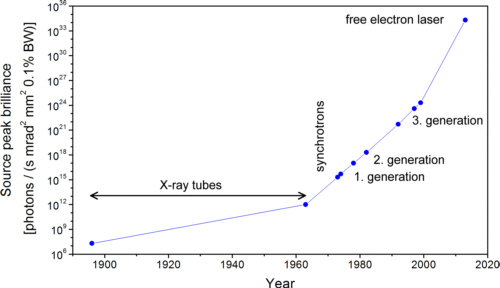Today X-rays find a use in many fields of applications, e.g. all kinds of research, medical imaging and therapy, industrial radiography etc. X-rays can either originate from radioactive isotopes or be generated by different kinds of devices. Each type of source has got its advantages and disadvantages:
| Source | Intensity | Size of the source | Light directed? | Light polarized? | Intensity modulation? |
| Radioactive isotopes | low | small | no | no | no |
| Stars | low | large but distant | yes (where observed) | partly | sometimes |
| X-ray tubes | low | table top | no | no | no |
|
Synchrotrons |
very high | large: own building | yes | yes | periodic pulses |
| Plasma sources | high | table top | no | no | pulses |
These are the most common X-ray sources. There are some more like e.g. natural deposits of radioisotopes or scientific curiosities as the "sticky tape X-rays" where pulsed, low intensity X-rays origin from triboluminescence when common office sticky tape is peeled of a surface under partial vacuum.
The intensities achieved with technical X-ray sources have increased dramatically since W. C. Röntgen built his first X-ray tube. With the invention of synchrotrons and free electron lasers, that will be used in a few years, the peak brilliance of X-ray sources has increased by the incredible factor of about 1026 since 1896 (fig. 1). The technical progress is characterized by continuous improvements and great leaps due to the introduction of new basic principles.

Fig. 1: Increasing peak brilliance of technical X-ray sources over the decades1
1 data analogue to http://photon-science.desy.de


